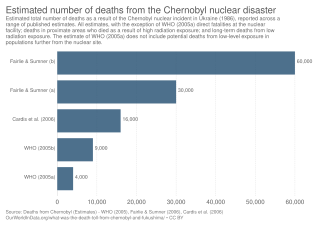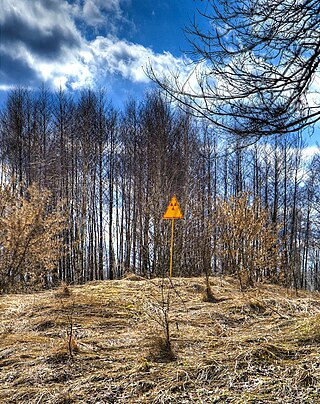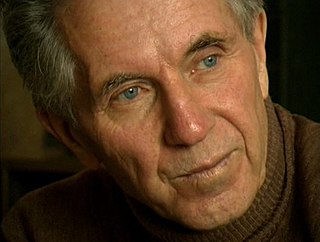
Chernobyl or Chornobyl is a partially abandoned city in the Chernobyl Exclusion Zone, situated in the Vyshhorod Raion of northern Kyiv Oblast, Ukraine. Chernobyl is about 90 kilometres (60 mi) north of Kyiv, and 160 kilometres (100 mi) southwest of the Belarusian city of Gomel. Before its evacuation, the city had about 14,000 residents. While living anywhere within the Chernobyl Exclusion Zone is technically illegal today, authorities tolerate those who choose to live within some of the less irradiated areas, and around 1,000 people live in Chernobyl today.

Pripyat, also known as Prypiat, is an abandoned city in northern Ukraine, located near the border with Belarus. Named after the nearby river, Pripyat, it was founded on 4 February 1970 as the ninth atomgrad to serve the nearby Chernobyl Nuclear Power Plant, which is located in the adjacent ghost city of Chernobyl. Pripyat was officially proclaimed a city in 1979 and had grown to a population of 49,360 by the time it was evacuated on the afternoon of 27 April 1986, one day after the Chernobyl disaster.

The Chernobyl Nuclear Power Plant Zone of Alienation is an officially designated exclusion zone around the site of the Chernobyl nuclear reactor disaster. It is also commonly known as the Chernobyl Exclusion Zone, the 30-Kilometre Zone, or The Zone.

The Chernobyl Nuclear Power Plant is a nuclear power plant undergoing decommissioning. ChNPP is located near the abandoned city of Pripyat in northern Ukraine, 16.5 kilometers (10 mi) northwest of the city of Chernobyl, 16 kilometers (10 mi) from the Belarus–Ukraine border, and about 100 kilometers (62 mi) north of Kyiv. The plant was cooled by an engineered pond, fed by the Pripyat River about 5 kilometers (3 mi) northwest from its juncture with the Dnieper.

The Chernobyl disaster began on 26 April 1986 with the explosion of the No. 4 reactor of the Chernobyl Nuclear Power Plant, near the city of Pripyat in the north of the Ukrainian SSR, close to the border with the Byelorussian SSR, in the Soviet Union. It is one of only two nuclear energy accidents rated at seven—the maximum severity—on the International Nuclear Event Scale, the other being the 2011 Fukushima nuclear accident in Japan. The initial emergency response and subsequent mitigation efforts involved more than 500,000 personnel and cost an estimated 18 billion roubles—roughly US$68 billion in 2019, adjusted for inflation. It is considered the worst nuclear disaster in history.

The 1986 Chernobyl disaster triggered the release of radioactive contamination into the atmosphere in the form of both particulate and gaseous radioisotopes. As of 2022, it was the world's largest known release of radioactivity into the environment.

Chernobyl liquidators were the civil and military personnel who were called upon to deal with the consequences of the 1986 Chernobyl nuclear disaster in the Soviet Union on the site of the event. The liquidators are widely credited with limiting both the immediate and long-term damage from the disaster.
Aleksandr Fyodorovich Akimov was a Soviet engineer who was the supervisor of the shift that worked at the Chernobyl Nuclear Power Plant Reactor Unit 4 on the night of the Chernobyl disaster, 26 April 1986.
The Chernobyl disaster is the world's worst nuclear accident to date.

Slavutych is a city and municipality in northern Ukraine, purpose-built for the evacuated personnel of the Chernobyl Nuclear Power Plant after the 1986 disaster that occurred near the city of Pripyat. Geographically located within Chernihiv Raion, Chernihiv Oblast, Slavutych is administratively subordinated to the Kyiv Oblast and is part of Vyshhorod Raion. It is coterminous with Slavutych urban hromada, one of the hromadas of Ukraine. In 2021 the city had a population of 24,464.

Anatoly Stepanovich Dyatlov was a Soviet engineer who was the deputy chief engineer for the Chernobyl Nuclear Power Plant. He supervised the safety test, which resulted in the 1986 Chernobyl disaster, for which he served time in prison as he was blamed for not following the safety protocols. He was released due to health concerns in 1990.

The Red Forest is the ten-square-kilometre (4 sq mi) area surrounding the Chernobyl Nuclear Power Plant within the Exclusion Zone, located in Polesia. The name "Red Forest" comes from the ginger-brown colour of the pine trees after they died following the absorption of high levels of ionizing radiation as a consequence of the Chernobyl nuclear disaster on 26 April 1986. The site remains one of the most contaminated areas in the world today.

Vassili Nesterenko was a Soviet and Belarusian physicist from Ukraine and a former director of the Institute of Nuclear Energy at the National Academy of Sciences of Belarus (1977–1987).

Ukraine operates four nuclear power plants with 15 reactors located in Volhynia and South Ukraine. The total installed nuclear power capacity is over 13 GWe, ranking 7th in the world in 2020. Energoatom, a Ukrainian state enterprise, operates all four active nuclear power stations in Ukraine. In 2019, nuclear power supplied over 20% of Ukraine's energy.

Chernobyl: Consequences of the Catastrophe for People and the Environment is a translation of a 2007 Russian publication by Alexey V. Yablokov, Vassily B. Nesterenko, and Alexey V. Nesterenko, edited by Janette D. Sherman-Nevinger, and originally published by the New York Academy of Sciences in 2009 in their Annals of the New York Academy of Sciences series.

Chernobyl is a 2019 historical drama television miniseries that revolves around the Chernobyl disaster of 1986 and the cleanup efforts that followed. The series was created and written by Craig Mazin and directed by Johan Renck. It features an ensemble cast led by Jared Harris, Stellan Skarsgård, Emily Watson, and Paul Ritter. The series was produced by HBO in the United States and Sky UK in the United Kingdom.
The Chernobyl disaster remains the major and most detrimental nuclear catastrophe which completely altered the radioactive background of the Northern Hemisphere. It happened in April 1986 on the territory of the former Soviet Union. The catastrophe led to the increase of radiation in nearly one million times in some parts of Europe and North America compared to the pre-disaster state. Air, water, soils, vegetation and animals were contaminated to a varying degree. Apart from Ukraine and Belarus as the worst hit areas, adversely affected countries included Russia, Austria, Finland and Sweden. The full impact on the aquatic systems, including primarily adjacent valleys of Pripyat river and Dnieper river, are still unexplored.

Chernobyl: Abyss, also titled Chernobyl 1986, is a 2021 Russian disaster film directed by and starring Danila Kozlovsky. The film centres on a fictionalised firefighter who becomes a liquidator during the Chernobyl disaster. The film was released in Russia by Central Partnership on 15 April 2021, and was subsequently picked up by Netflix in July 2021.














